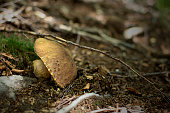Four Ways To Enhance Truffle Mushroom Why Expensive
페이지 정보

본문

One early argument in favour of the mushroom-to-truffle course of evolution was that, if evolution had been the other method, it would have been essential for that complicated spore discharge mechanism (frequent to all mushrooms) to have developed independently plenty of instances. In the case of stinkhorn/truffle-like pairs, the molecular proof signifies that the above-floor stinkhorns developed from truffle-like ancestors. Moreover, the truffle-like fungi produce a big selection of chemical attractants, so the evolution to above-ground stinkhorns (and fly-attracting compounds) might not have required great changes to the chemical factories within the truffle-like ancestors. On the other hand, the stinkhorns release their spores passively (relying on fly-attracting chemicals) so truffle-to-stinkhorn evolution does not demand the development of any complex spore release mechanism. The truffle-like fungi rely mainly on animals for spore dispersal. It's value noting that the mushrooms launch their spores forcibly (SEE MUSHROOM SPORE Release Section). Additionally, you will see the word "hypogeous" - but this actually means "beneath ground", so it would be inappropriate for anything like Setchelliogaster, shown below, with its above-ground fruiting physique. You'll be able to see numerous struts between the outer casing and the central core.
The perfect you are able to do is develop suitable trees in optimum conditions, which suggests thoughtfully selecting a tree is crucial. However, even if there were no cortina, the shortness of the stem implies that the mature fruiting bodies virtually always stay buried in leaf litter. However, right here additionally, extra detailed analysis has proven close connections between the truffle-like species and the "peculiar" cup-like ascomycetes. However, on this webpage the expression "truffle-like" can be used as an all-encompassing term, simply because many people are conversant in the word "truffle", so utilizing "truffle-like" instantly relates these fungi to a familiar idea. It has been known for a while that Thaxterogaster and Cortinarius are intently associated, however obviously they're totally different as a result of the spore-bearing tissue of Thaxterogaster is enclosed while in Cortinarius the caps open out fully to expose the spore-bearing gills to the air. You'll instantly notice several points - it definitely is mushroom-like (with stem, cap and gills), but the stem may be very brief and the cortina is both fairly dense and persistent. It's current in the younger specimens, however is very flimsy and torn apart as the cap expands, in order that in fully mature specimens there are often few traces left and the spores are unimpeded of their passage from the gills to the open air beneath the cap.
On the left is a species of Laccaria, a mushroom genus where many of the species are a pinkish-red colour all through and on the precise is Hydnangium carneum, a pinkish to pinkish-red truffle-like species. The first monograph on Australian fungi was the 1892 Handbook of Australian Fungi, written by the English mycologist MC Cooke who commented that Australia had few subterranean species. Men who graduated from Stanford support younger men who graduate from Stanford. The rationale for this explosion in information was that there were now resident mycologists who have been in a position to gather over prolonged durations (taking quick benefit of excellent circumstances) and examine their collections critically. Getting started now's one of the best technique to reap the advantages of rising your individual SLICED BLACK TRUFFLES AND WHITE OLIVE OIL TRUFFLE SET. While the spores are forcibly shot from the gills, in the same means as in any odd mushroom, the dense cortina greatly hinders the passage of the spores beyond the confines of the cap.
The Australian truffle-like fungi are mostly mycorrhizal and have critical interactions with various native marsupials, a subject that will likely be dealt with below. As noted within the History Section, the 19th century saw Australian fungal collections sent to European mycologists for examination and publication and, given Australia's colonial historical past, it's not surprising that the majority of that work was performed by English mycologists. The History Section offers temporary details of the key resident mycologists. Ascomycetes and basidiomycetes are defined in the 2 Major Groups section. The high ranges of endemism (at both the generic and species ranges) shows Australia to be a significant centre of evolution of truffle-like fungi. By comparability, there are solely a couple of hundred truffle-like species in Europe - an area that has been way more intensively studied than Australia. As famous above, about 50% of the truffle-like genera found in Australia are endemic but in terms of species, the level of endemism is about 95%. Obviously there are various genera found in Australia, which are also discovered elsewhere - but for any such genus, the Australian species inside the genus are nearly always different to the overseas species in the identical genus.
- 이전글работа удаленно на дому свободный график без опыта через интернет набор текстов 24.11.04
- 다음글Fire Media Wall: 10 Things I'd Like To Have Known Sooner 24.11.04
댓글목록
등록된 댓글이 없습니다.

